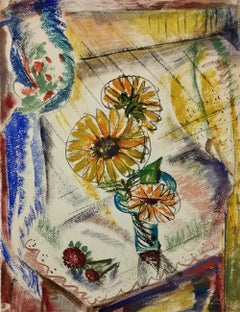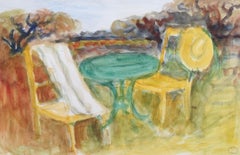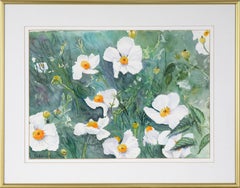Beulah Stevenson Still-life Drawings and Watercolors
to
1
Overall Width
to
Overall Height
to
1
1
1
1
1
1
2
85
69
42
30
1
Artist: Beulah Stevenson
Beulah Stevenson, Three Small Sunflowers and Two Roses by the Window
By Beulah Stevenson
Located in New York, NY
This Three Small Sunflowers still-life by Beulah Stevenson (1890-1965) is a joyful modernist composition. With just touches of color she indicates a window and colorful curtains blow...
Category
Mid-20th Century Modern Beulah Stevenson Still-life Drawings and Watercolors
Materials
Watercolor
Related Items
The Terrace
By Maurice Savin
Located in London, GB
'The Terrace', watercolour on art paper, by Maurice Savin (circa 1950s). An inviting scene from the South of France depicts a quiet sun terrace on a balmy day with azure skies. The v...
Category
1950s Modern Beulah Stevenson Still-life Drawings and Watercolors
Materials
Paper, Watercolor
White Poppies - Botanical Watercolor on Paper
Located in Soquel, CA
White Poppies - Botanical Watercolor on Paper
Detailed floral watercolor by Harry Federico (American, 1922-2022). Several white poppies ...
Category
21st Century and Contemporary American Modern Beulah Stevenson Still-life Drawings and Watercolors
Materials
Watercolor, Laid Paper
$747 Sale Price
35% Off
H 21.25 in W 27.25 in D 1 in
Sea Shells – Blue & Gold
By Zama Vanessa Helder
Located in Los Angeles, CA
Sea Shells – Blue & Gold, c. 1940s, watercolor on paper, signed upper left, 15 x 19 ¼ inches (image); title and artist’s name and address inscribed verso, presented in a newer glazed...
Category
1940s American Modern Beulah Stevenson Still-life Drawings and Watercolors
Materials
Paper, Watercolor
Small, Charming, Fauvist Painting Michel Henry French Modernist School of Paris
By Michel Henry
Located in Surfside, FL
Michel-Henry was born in Langres in 1928 and has shown strong passion for drawing since his childhood. Michel-Henry is acknowledged as an important painter in French contemporary art. From 1952 his work has periodically been singled out for France's highest prizes and awards. The French Government, the City of Paris , the Museum of Valence , Bogota and the Museum of Alencon are among the distinguished institutions who have acquired his work for their permanent collections.
Born in Langres in 1928 the aspiring artist attended the Ecole Nationale Superieure des Beaux-Arts in Paris. He later studied with Narbonne , Georg, Chapelain-Midy and Legueult. In 1957 he became a member of the House of Descartes in Amsterdam and the following year was named member of the Casa Velazquez in Madrid , honors which are exceptional for a young painter.
He is a member of the Salon d'Automne as well as a member of its jury, he also exhibits in the Salon de la Société Nationale des Beaux-Arts, the Salon Comparisons, and the Salon Terres Latines. In 1976 he shared in the honor of presenting the Salon d'Automne exhibition in Japan .
Michel-Henry blends delicate tones and strong and fascinating accents into his compositions of flower still life, landscapes and marines. An avid interest in nature is the predominant quality of his luminous works.
As a French artist whose works are known internationally, Michel-Henry over a period of twenty eight years has earned the status of a goodwill ambassador in a universal world of cultural exchanges. For his dedication and unselfish contributions to art and artists from all lands he was honored by his country by being awarded the prestigious - la Croix de Chevalier de la Légion d'Honneur - on January 1, 1981 by the French Minister of Culture Mr. Jean Philippe Lecat. Michel Henry exhibited at prestigious galleries in Paris (Avenue Matignon) and New York (Madison Avenue) alongside such artists as Pablo Picasso, Fernand Leger, Armand Guillaumin, Maurice Utrillo and Claude Venard. He is part of School of Paris artists that included Marcel Cosson, Jean Jansem, Leni-Dael, Raoul Dufy, Claude Salomon, Michel Kouliche...
Category
1960s Modern Beulah Stevenson Still-life Drawings and Watercolors
Materials
Paper, Gouache
"Dahlias" Chiura Obata, Japanese American, Red and Blue Delicate Floral Work
By Chiura Obata
Located in New York, NY
Chiura Obata
Dahlias, 1940
Signed, dated and stamped lower right
Watercolor on paper
15 x 9 5/8 inches
Born in the Okayama prefecture of Japan, Chiura Obata was adopted by his uncle, an artist. As a child he was trained in ink painting, and at 14 he was apprenticed to the painter Murata Tanryo in Tokyo. He also studied with Kogyo Terasaki and Goho Hasimoto.
In 1903, Obata moved to San Francisco and began working as an illustrator for The New World and The Japanese American, two of the city's Japanese newspapers. He also did work as a commercial designer. Obata helped establish the East West Art Society in San Francisco in 1921, which sought to promote cross-cultural understanding through art. This goal was reflected in his embrace of the Nihonga style, which fused traditional Japanese sumi-e ink painting with the conventions of western naturalism.
He spent much of the 1920s painting landscapes throughout California, and among his favorite subjects were mountain landscapes. In 1927, he visited Yosemite and the Sierra Nevada, creating over a hundred paintings and sketches of the high country. Obata stayed in the USA until the death of his father in 1928.
Between 1928 and 1932, he worked in Tokyo as a painter and transformed his California landscape watercolors...
Category
1940s Modern Beulah Stevenson Still-life Drawings and Watercolors
Materials
Paper, Watercolor
$4,500
H 22.5 in W 16.5 in
Israeli Yosl Bergner Modernist Watercolor Painting Drawing Pots, Pans
By Yosl Bergner
Located in Surfside, FL
Abstract Composition, Kitchen Utensils.
Ink and watercolor of kitchen implements. Hand signed in Hebrew upper left. Dimensions: (Frame) H 25" x 18" (Sight) H 18.5" x W 11.75"
Bergn...
Category
Mid-20th Century Modern Beulah Stevenson Still-life Drawings and Watercolors
Materials
Archival Ink, Watercolor
$1,500
H 25 in W 18 in
Israeli Yosl Bergner Modernist OIl Painting Kitchen Bottles Coffee, Vase
By Yosl Bergner
Located in Surfside, FL
Yosl Bergner
Abstract Composition, Kitchen Utensils.
Oil painting of kitchen implements. Hand signed in English bottom right
Titled and signed ve...
Category
Mid-20th Century Modern Beulah Stevenson Still-life Drawings and Watercolors
Materials
Archival Ink, Watercolor
$4,800
H 25 in W 18 in
Flower Bouquet
Located in Los Angeles, CA
(Note: This work is part of our exhibition Connected by Creativity: WPA Era Works from the Collection of Leata and Edward Beatty Rowan)
Watercolor on paper, 12 x 9 ½ inches unframed sheet, 15 x 12 ½ inches framed, signed lower left
About the Artist:
Nan Watson...
Category
1930s American Modern Beulah Stevenson Still-life Drawings and Watercolors
Materials
Watercolor
"Nasturtiums" Chiura Obata, Japanese American, Red and Blue Delicate Flowers
By Chiura Obata
Located in New York, NY
Chiura Obata
Nasturtiums, circa 1940
Signed and stamped lower left
Watercolor on paper
15 x 9 5/8 inches
Born in the Okayama prefecture of Japan, Chiura Obata was adopted by his uncle, an artist. As a child he was trained in ink painting, and at 14 he was apprenticed to the painter Murata Tanryo in Tokyo. He also studied with Kogyo Terasaki and Goho Hasimoto.
In 1903, Obata moved to San Francisco and began working as an illustrator for The New World and The Japanese American, two of the city's Japanese newspapers. He also did work as a commercial designer. Obata helped establish the East West Art Society in San Francisco in 1921, which sought to promote cross-cultural understanding through art. This goal was reflected in his embrace of the Nihonga style, which fused traditional Japanese sumi-e ink painting with the conventions of western naturalism.
He spent much of the 1920s painting landscapes throughout California, and among his favorite subjects were mountain landscapes. In 1927, he visited Yosemite and the Sierra Nevada, creating over a hundred paintings and sketches of the high country. Obata stayed in the USA until the death of his father in 1928.
Between 1928 and 1932, he worked in Tokyo as a painter and transformed his California landscape watercolors...
Category
1940s Modern Beulah Stevenson Still-life Drawings and Watercolors
Materials
Paper, Watercolor
Chiura Obata"Nasturtiums" Chiura Obata, Japanese American, Red and Blue Delicate Flowers, circa 1940
$4,500
H 22.5 in W 16.5 in
Garden Flowers
By Charles Demuth
Located in New York, NY
Charles Demuth was one of the most complex, talented, and deeply sensitive artists of the American modern period. Whether he was painting floral still lifes, industrial landscapes, or Turkish bathhouses, art was, for Demuth, fraught with personal meaning. A fixture of the vanguard art scene in New York, Demuth navigated the currents of Modernism, producing some of the most exquisite watercolors and original oil paintings in twentieth-century American art.
Demuth was born in Lancaster, Pennsylvania, the only child of a well-to-do family. He had an awkward and introverted childhood shaped by a childhood illness, Perthes, a disease of the hip that not only left him permanently lame, but, as part of the “cure,” bedridden for two years in the care of his mother. This long period of incapacitation had a deep impact on Demuth, who came to see himself as an invalid, an outsider who was different from everyone else. It was perhaps during this period of indoor confinement that his keen interest in art developed. Several relatives on his father’s side had been amateur artists, and, following his convalescence, his mother encouraged his artistic pursuits by sending him to a local painter for instruction. The majority of his early pictures are of flowers, a subject for which Demuth maintained a lifelong passion.
Following high school, Demuth enrolled at the Drexel Institute of Art in Philadelphia, a school renowned for its commercial arts program. He advanced through the program rapidly, and, in 1905, at the encouragement of his instructors, he began taking courses at the Pennsylvania Academy of the Fine Arts. The two leading teachers then at the Academy were William Merritt Chase and Thomas Anshutz. Anshutz, himself a former student of Thomas Eakins, was well liked by his students, and is best known as the teacher of Robert Henri, John Sloan, and several of the other artists of the Ashcan School. Demuth, too, adopted a similar idiom, working in a controlled, realistic manner while at the Academy, where he remained until 1910.
In 1907, Demuth made his first trip to Europe, staying in Paris. He spent time on the periphery of the art scene composed of the numerous American artists there, including John Marin and Edward Steichen. He returned to Philadelphia five months later, and immediately resumed courses at the Academy. Despite his introduction to advanced modern styles in Europe, Demuth’s work of this period retains the academic style he practiced before the trip. It wasn’t until he had summered at New Hope, Pennsylvania, in 1908 and 1911, that his style began to evolve. New Hope was a prominent American Impressionist art colony whose members were largely affiliated with the Pennsylvania Academy. Demuth dropped the conservative tone of his style and adopted a freer and more colorful palette.
Although he remained based in Philadelphia, Demuth frequently went to New York during this period. Many of the same American artists of the Parisian art scene Demuth had encountered on his earlier European trip now formed the nucleus of New York’s avant-garde, which centered around Alfred Stieglitz’s 291 gallery. It wasn’t long before Demuth began to apply modernist-inspired strategies to his work. He was particularly influenced by the watercolor work of John Marin, also a former student of Anshutz, whose bold use of color in the medium Demuth freely adapted into looser washes of color.
In 1912, Demuth again left for Paris, this time studying in the Académie Moderne, Académie Colorossi, and Académie Julian. In Paris Demuth met the American modernist Marsden Hartley. Hartley, a principal figure in the expatriate art circle, acted as a mentor to Demuth, and introduced him to the wide array of modern styles currently practiced in Europe. Hartley also introduced Demuth to many of the members of the Parisian avant-garde, including Gertrude Stein. Demuth was an aspiring writer, and he spent many hours in conversation with Stein. He wrote extensively during this period, and published two works shortly after his return to America. He also developed an interest in illustrating scenes from literary texts. From 1914 to 1919, Demuth produced a series of watercolors of scenes from books such as Emile Zola’s Nana and Henry James’s The Turn of the Screw.
Upon his return to America, Demuth settled in New York. In 1914, Demuth had his first one-man show at Charles Daniel’s gallery, which promoted emerging modern American artists, including Man Ray, Rockwell Kent, Yasuo Kuniyoshi, Stuart Davis, and Max Weber. Demuth drew closer to the artistic vanguard in New York, becoming friends with many in the Stieglitz and Daniel circles, including Georgia O’Keeffe, Marcel Duchamp, Carl Van Vechten, and Edward Fiske.
New York’s cosmopolitan atmosphere and active nightlife appealed greatly to Demuth. In a sketchy style well suited to watercolor, he painted many vaudeville and circus themes, as well as nightclub, café, and bathhouse scenes. Often with Duchamp, Demuth took part in an urban subculture replete with nightclubs, bars, drugs, and sexual permissiveness, which, for a homosexual artist like himself, allowed room for previously unattainable personal expression. Demuth’s pictures of sailors, bathhouses, and circus performers embody a sensual and sexual undercurrent, expressing the artist’s sense of comfort and belonging in the bohemian subculture of New York.
Simultaneously, Demuth deepened his interest in floral pictures, painting these almost exclusively in watercolor. His style evolved from the broad color washes of his earlier pictures to more spare, flattened, and sinuous compositions, inspired by the drawings of Aubrey Beardsley and other artists of the Aesthetic Movement. Demuth’s flower watercolors are moody and atmospheric, sensuous and elegant, introspective and yet full of expressive power. Moreover they are beautiful, and are unequivocally among the finest still lifes in American art. Despite numerous subsequent artistic undertakings that led him in a variety of directions, Demuth never stopped painting flower pictures, ultimately adding fruits and other still-life objects to his repertoire.
In 1916, Demuth began to develop a style later known as Precisionism, a form of landscape painting infused with Cubism, in which space is divided into precisely drawn geometric regions of color. Demuth first began to paint the landscape in an appropriated Cubist mode while on a trip with Hartley to Bermuda. In these early landscapes, in which the curvilinear forms of trees intersect the geometrically articulated architectural forms, Demuth explored ideas that shaped the future development of modernism in America.
The full realization of Demuth’s explorations came after his return to America in 1917, when he turned his attention to industrial subjects. These works derive from a “machine aesthetic,” espoused by New York artists such as Francis Picabia, Joseph Stella, Albert Gleizes, and Duchamp, by which artists viewed machines as embodying mystical, almost religious significance as symbols of the modern world. Rather than painting the skyscrapers and bridges of New York as did most of his like-minded contemporaries, Demuth returned to his home town of Lancaster, where he painted factories and warehouses in a Precisionist idiom. The titles for these pictures are often contain literary references, which serve as clues for the viewer to aid in the decoding of the artist’s meaning.
In 1923, Demuth planned a series of abstract “poster portraits” of his friends and contemporaries in the New York art and literary scene. In these “portraits,” Demuth combined text and symbolic elements to evoke the essential nature of his sitters’ distinguishing characteristics. In this fashion, he painted portraits of such artists as Georgia O’Keeffe, John Marin, and Arthur Dove. His most famous poster portrait, I Saw the Figure 5 in Gold...
Category
20th Century American Modern Beulah Stevenson Still-life Drawings and Watercolors
Materials
Paper, Watercolor
Kutschen (carriages); Group of four designs for hansom cabs.
By Alfred Juergens
Located in Middletown, NY
Four pencil drawings, each with hand coloring in watercolor, each 6 3/4 x 10 inches (sheet) (172 x 254 mm), full margins. Each with inscriptions and notations by the artist in the up...
Category
Mid-20th Century American Modern Beulah Stevenson Still-life Drawings and Watercolors
Materials
Handmade Paper, Watercolor, Pencil
$800
H 6.78 in W 10.01 in
Automotive design for Alexis Kellner AG Berlin
By Herschu (Herbert Schultz)
Located in London, GB
Half-Limousine coachwork design for an Austro-Daimler.
Gouache and watercolour heightened with gum-arabic on very dark green card, annotated in pale ink with body type below, numbere...
Category
1930s Modern Beulah Stevenson Still-life Drawings and Watercolors
Materials
Watercolor, Gouache, Handmade Paper
$2,069
H 10.63 in W 16.54 in
Beulah Stevenson still-life drawings and watercolors for sale on 1stDibs.
Find a wide variety of authentic Beulah Stevenson still-life drawings and watercolors available for sale on 1stDibs. You can also browse by medium to find art by Beulah Stevenson in paint, watercolor and more. Much of the original work by this artist or collective was created during the 20th century and is mostly associated with the modern style. Not every interior allows for large Beulah Stevenson still-life drawings and watercolors, so small editions measuring 15 inches across are available. Customers who are interested in this artist might also find the work of Sylvia Spicuzza, Andy Warhol, and Ian Hornak. Beulah Stevenson still-life drawings and watercolors prices can differ depending upon medium, time period and other attributes. On 1stDibs, the price for these items starts at $1,500 and tops out at $1,500, while the average work can sell for $1,500.


